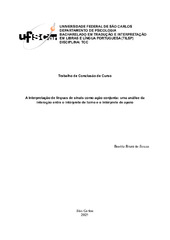| dc.contributor.author | Souza, Beatriz Bruni de | |
| dc.date.accessioned | 2022-02-14T18:21:28Z | |
| dc.date.available | 2022-02-14T18:21:28Z | |
| dc.date.issued | 2021-01-11 | |
| dc.identifier.citation | SOUZA, Beatriz Bruni de. A interpretação de línguas de sinais como ação conjunta: uma análise da interação entre o intérprete de turno e o intérprete de apoio. 2021. Trabalho de Conclusão de Curso (Graduação em Língua Brasileira de Sinais-Libras/Língua Portuguesa) – Universidade Federal de São Carlos, São Carlos, 2021. Disponível em: https://repositorio.ufscar.br/handle/ufscar/15598. | * |
| dc.identifier.uri | https://repositorio.ufscar.br/handle/ufscar/15598 | |
| dc.description.abstract | It has been increasingly becoming common, in many interpreting situations between
Brazilian Sign Language (Libras) and Portuguese, that the interpreters do not work
by themselves. For several reasons, among which dealing with the cognitive burden
demanded by the activity, many interpreters have been preferring to work in
association with other interpreters (RID, 2007; HOZA, 2010; BRÜCK, 2011;
RUSSELL, 2011; COKELY, HAWKINS, 2013, quoted by NOGUEIRA, 2016). While a
first interpreter takes the turn (called “interpreter of the turn”), a second one assists
the interpreter of the turn as a supporter in different ways (called “supporter
interpreter”) (NOGUEIRA, 2016; SANTIAGO, 2017). The purpose of this
investigation was to analyze and describe the interaction between the interpreter of
the turn and the supporter interpreter in a linguistic interpretation involving Libras and
Portuguese. For that, we assume Herbert Clark’s thesis (1996) that the language
use is a form of joint action in which the participants engage and coordinate their
actions so they concretize a joint project. The interpreters work as participants of the
situations they are interpreting and their joint work is the focus of interest in this
paper. The corpus of this research was constituted by a videotap of the interpretation
of a class in virtual format, in which two interpreters worked as a team. The analysis
presented in this paper were made after transcribing the video in ELAN, a
transcription software created to work on multimodal data analysis. With this work,
we could conclude that, to describe to the interaction in a broader way, we must look
beyond the mental processes involving the interaction and observe the gestural and
corporal elements in the interaction between the interpreter of the turn and the
supporter interpreter. | eng |
| dc.description.sponsorship | Não recebi financiamento | por |
| dc.language.iso | por | por |
| dc.publisher | Universidade Federal de São Carlos | por |
| dc.rights | Attribution-NonCommercial-NoDerivs 3.0 Brazil | * |
| dc.rights.uri | http://creativecommons.org/licenses/by-nc-nd/3.0/br/ | * |
| dc.subject | Interpretação de libras | por |
| dc.subject | Intérprete de apoio | por |
| dc.subject | Ação conjunta | por |
| dc.subject | Interação | por |
| dc.subject | Libras interpretation | eng |
| dc.subject | Support interpreter | eng |
| dc.subject | Joint action | eng |
| dc.subject | Interaction | eng |
| dc.title | A interpretação de línguas de sinais como ação conjunta: uma análise da interação entre o intérprete de turno e o intérprete de apoio | por |
| dc.title.alternative | The interpretation of sign languages as a joint action: an analysis of the interaction between two interpreters working togelher | eng |
| dc.type | TCC | por |
| dc.contributor.advisor1 | Silva, João Paulo da | |
| dc.contributor.advisor1Lattes | http://lattes.cnpq.br/6111069189059770 | por |
| dc.description.resumo | Está se tornando cada vez mais comum que, em muitas situações de interpretação
entre língua brasileira de sinais (libras) e português, os intérpretes não atuem
sozinhos. Por várias razões, dentre as quais lidar com a carga cognitiva demandada
pela atividade, muitos intérpretes têm preferido trabalhar em parceria (RID, 2007;
HOZA, 2010; BRÜCK, 2011; RUSSELL, 2011; COKELY, HAWKINS, 2013, citados
por NOGUEIRA, 2016). Enquanto um intérprete assume o turno (nomeado como
‘intérprete do turno’), o outro intérprete serve ao que está atuando no turno como
apoio, de diferentes maneiras (nomeado como ‘intérprete de apoio’) (NOGUEIRA,
2016; SANTIAGO, 2017). O objetivo desta pesquisa foi analisar e descrever a
interação entre o ‘intérprete do turno’ e o ‘intérprete de apoio’ na interpretação
linguística envolvendo libras e português. Para tanto, assumimos a tese de Herbert
Clark (1996), de que o uso da língua é uma forma de ação conjunta, em que os
participantes se engajam e coordenam suas ações para concretizar um projeto
conjunto. Os intérpretes de libras atuam como participantes das situações em que
estão interpretando e o trabalho conjunto levado a cabo por eles é o foco de
interesse deste trabalho. O corpus desta pesquisa foi constituído do vídeo da
interpretação de uma aula em formato não-presencial, em que dois intérpretes
atuaram em parceria por meio virtual. As análises realizadas neste trabalho foram
feitas a partir da transcrição do vídeo no software ELAN, que é um software de
transcrição criado para análise de dados multimodais. Com este trabalho, pudemos
concluir que, para descrever para a interação de forma mais ampla, é necessário
que olhemos além dos processos mentais que envolvem a interação e voltemos
nosso olhar para a os elementos gestuais e corporais na interação entre intérpretes
de turno e de apoio. | por |
| dc.publisher.initials | UFSCar | por |
| dc.subject.cnpq | LINGUISTICA, LETRAS E ARTES::LINGUISTICA::TEORIA E ANALISE LINGUISTICA | por |
| dc.publisher.address | Câmpus São Carlos | por |
| dc.contributor.authorlattes | http://lattes.cnpq.br/5265001180078254 | por |
| dc.publisher.course | Tradução e Interpretação em Língua Brasileira de Sinais-Libras/Língua Portuguesa - TILSP | por |

